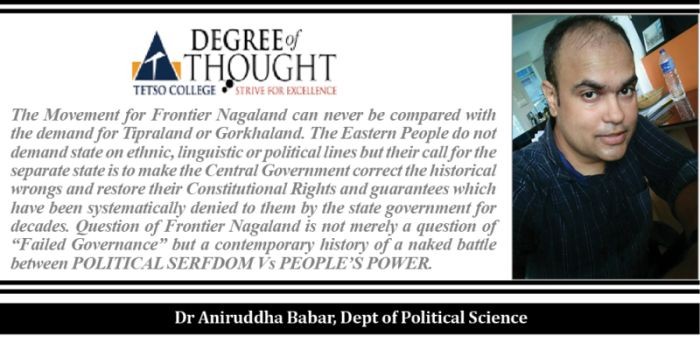
EASTERN NAGALAND, a land of mysteries and unique history- a region fortified by the sentinels of the Indo-Myanmar Border- mighty Mt. Saramati and the great Mt. Khelia (Khulio) King- protecting and guarding the people of the region which have been thrown into the eternal darkness where the lights of “NEW SECRETARIAT COMPLEX, KOHIMA” could never reach. I could be one of those handful of people who got opportunities to travel, explore, study and document the Eastern region of the Indian state of Nagaland, the people of which are now all out to fight for the formation of ‘separate state’ which they proudly call “FRONTIER NAGALAND”. My observations are based on my personal experiences.
The problems that Eastern Nagaland is suffering from are multi-dimensional in nature, the presence of which supply constructive evidence to prove the systematic failure of “KOHIMA” in delivering ‘Constitutional Promises’ to the people of the East. Eastern Nagaland people face issues which are deeper and more serious that have directly impacted the lives of the people and further deprived them from exercising their constitutional rights which resulted into systematic denial of ‘Constitutional Justice’. On one hand there has been a rich discourse on ideal governance, there have been years long debates on the political rights of the Nagas, but on the other hand somehow we conveniently ignore and forget even to acknowledge the suffering of the people of the East.
Tourist attractions like the International Trade Centre (ITC) at Dan, Wolam (Pangsha), under Noklak District (which anyway is a dead entity totally ignored by the Government) does not have ‘humane’ road conditions for visitors to visit. Similarly, if one wishes to explore Mt. Khelia (Khulio) King which is relatively unknown and almost an unexplored mountain one has to either go to Choklangkan or Wui village, however, the road condition is dangerous. Also, there are sufficient reasons to believe that in the name of “Gram Sadak Yojna”, no sufficient work which can be appreciated has ever been done in the remote villages of the eastern region. Thanamir Village (Last village located at Indo-Myanmar Border)- a base village for Mt Saramati climb is known all over India as an apple village for the superior quality of apple produced there, however, it is shameful to admit that no proper, commercially viable road exists to connect Thanamir to the outer world. Poor road connectivity impacts access to public facilities (which are extremely limited in the region). The Eastern Nagaland also faces problems of low quality infrastructure. For instance, despite availability of visible road density, access remains a problem as many roads are dilapidated and prone to landslides, affecting transportation of people and goods and services, especially during monsoons.
Villages in Eastern Districts do not have sufficient provision for “street lights” as well as regular electricity. Water crisis is a reality of Eastern Nagaland. Moreover, the health care services available in the region are not up to the mark. Public Health centers have evidently exhibited the ‘limits’ within which they are forced to operate. Halted development on infrastructure is affecting citizens’ access to healthcare institutions in the eastern region–most of which are government-run in these predominantly rural parts. Also, according to NITI Ayog’s Report on the North-East region on ‘Sustainable Development Goals’- all six districts in Eastern Nagaland areas have been mentioned as ‘unsatisfactory’ and have been granted the status of ‘aspirational’ category. The per capita income of the Eastern Nagaland region has been found to be lesser than the rest of the Nagaland state. There has been a serious employment crisis. There is no equal or sufficient representation of the Eastern region in government services. The government school buildings are in dilapidated condition. Districts like Mon and Noklak are engulfed in clutches of DRUGS TRAFFICKING AND HIV-AIDS.
It has been observed that, in comparison to most advanced tribes of Nagaland, the tribes living in eastern region are far behind in terms of educational and employment status. It is a known fact that Westernisation of the ‘advance Naga Tribes’ and their culture provided them with significant advantage, recognition, and they were also able to influence the Government through their presence. Since Nagaland received the recognition of a state, it has experienced development to some extent. Educated people have become rich and powerful. However, like remaining India, there was no caste system among Naga tribes, nor there have been any historical records of marginalized tribes. However, inconsistency and inequality in terms of getting government jobs, getting access to the share of development or overall resource allocation (between Advanced Tribes and the Eastern Nagaland) have resulted in marginalizing the Eastern Naga Tribes.
People living in the eastern region have based their strong belief on the historical and epidemiological factors that resources of the state (which could include social status, education, employment, financial aids, geographical development, and other human growth requirements) are only for the utilization and benefit of the western Naga tribes. By exploiting various resources of the state, these tribes have become the advanced tribes and eastern tribes have been left backward and primitive. The demand for the state has emerged from the consciousness that statehood will provide equal opportunities of growth and development to eastern tribes, as received by western tribes.
It is a fact that the present area of Eastern Nagaland was historically and geographically never under any foreign rule before the advent of independence of India. British colonial rulers had left the ENPO area unconquered and unoccupied and therefore left it as an ‘excluded and un-administered area’. Formation of the state of Nagaland in 1963 was not possible without the inclusion of Tuensang Frontier Division. The special provisions for the Tuensang Area have been made in the Art. 371 (A) of the Constitution of India.
Article 371(A) Clause 2(B) of the constitution of India, under which the central government provided separate funds to Tuensang district (from where the six districts were carved out) through Nagaland state. Also, Article 371 (A) Clause 2 (C) clearly indicates the ‘unique’ constitutional identity of Eastern region stating that, “NO Act of the Legislature of Nagaland shall apply to the Tuensang district unless the Governor, on the recommendation of the regional council, by public notification so directs…”The words reflected in Clause 2 ( C ) is an evidence sufficient enough to ‘frame out’ the ‘actual’ constitutional status of the Former Tuensang District and subsequently the six districts that carved out of it. It is also a reminder as to what the Government of Nagaland ought to have done.
The draftsmen of the Indian Constitution did not believe that the states, districts and mandals within India are static, unchanging, and permanent. They had the maturity to accept that States would evolve and change, and hence made provisions for the creation of new States in the Indian Union. In a Raja Ram Pal V Hon'ble Speaker, (2007) 3 SCC 184 the Supreme Court has held that India adopted a 'loose federal structure', which is an indestructible Union of destructible Units.
Frontier Nagaland Movement could also be considered as the story influenced by a mix of political and social factors. Development and welfare of eastern Naga tribes is the main reason behind the Frontier Nagaland movement. In constitutional democracy underlined by the principles of democratic liberalism, nothing could be more important than the ‘JUSTICE’ for the people. Therefore, in the present case of Eastern Naga Tribes, if justice can be brought through the constitutional channels and political canals in the form of a separate state, if such a political experiment can change the life of a large number of ‘forgotten’ people, then the central government should not hesitate to take necessary steps. The welfare of the people should be the ultimate guiding principle for the policy of government. Welfare and justice for ‘commonest among the commons’ will be the ultimate and final measuring unit of the success of Constitutional Democracy—The People’s Democracy.
Degree of Thought is a weekly community column initiated by Tetso College in partnership with The Morung Express. Degree of Thought will delve into the social, cultural, political and educational issues around us. The views expressed here do not reflect the opinion of the institution. Tetso College is a NAAC Accredited UGC recognised Commerce and Arts College. The editors are Dr Hewasa Lorin, Dr Aniruddha Babar, Khangpuiliu Pamei, Rinsit Sareo, Meren and Kvulo Lorin. For feedback or comments please email: dot@tetsocollege.org.






